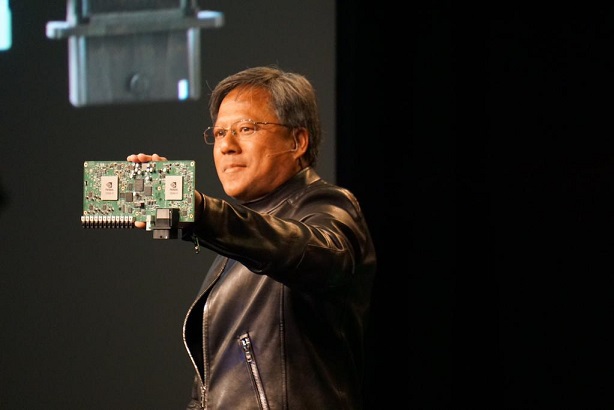BENGALURU: A 36.9 per cent jump in revenue from its gaming platform at $2,818 million (56.2 per cent of total revenue) for the year ended January 31, 2016 (FY-2016, current year) from $2,058 million for the year ended January 25, 2015 (FY -205) has helped ramp up NVIDIA revenue for FY-2016 by 7 per cent. NVIDIA reported revenue of $5,010 million in the current year as compared to $4,682 million in FY-2015. In terms of products, its graphics processing unit sales contribution to revenue has gone up to 83.6 per cent in the current year from 82 per cent in FY-2015. GPU sales increased by 9.1 per cent in FY-2016 to $4,187 million from $3,839 million in the previous year.
Net non-GAAP income in FY-2016 increased 16 per cent to $929 million from $801 million in the previous year. GAAP income in the current year increased 2.8 per cent in FY-2016 to $631 million from $614 million in the previous year.
Other platforms that contribute to NVIDIA income are Professional Visualization, Datacenter, Autocenter and OEM and IP. Professional Visualization reported 5.7 per cent decline in revenue to $750 million in FY-2016 from $795 million in FY-2015. Datacenter revenue increased 6.9 per cent to $339 million in FY-2016 from $317 million in FY-2015.Auto revenue increased by a phenomenal 74.9 per cent to $320 million in the current year from $183 million in the previous fiscal. OEM & IP revenue dropped 41.1 per cent to $783 million in FY-2016 as compared to $1,329 million in FY-2015.
Tegra revenue in the current year declined 3.5 per cent to $559 million in FY-2016 from $579 million in the previous year.
“We had another record quarter, capping a record year,” said NVIDIA co-founder and chief executive officer Jen-Hsun Huang, “Our strategy is to create specialized accelerated computing platforms for large growth markets that demand the 10x boost in performance we offer. Each platform leverages our focused investment in building the world’s most advanced GPU technology.
“NVIDIA is at the centre of four exciting growth opportunities – PC gaming, VR, deep learning, and self-driving cars. We are especially excited about deep learning, a breakthrough in artificial intelligence algorithms that takes advantage of our GPU’s ability to process data simultaneously,” he said
“Deep learning is a new computing model that teaches computers to find patterns and make predictions, extracting powerful insights from massive quantities of data. We are working with thousands of companies that are applying the power of deep learning in fields ranging from life sciences and financial services to the Internet of Things,” he added.
In Q4-2016 (quarter ended January 31 2016, current quarter), NVIDIA reported 12 per cent YoY growth in total revenue to $1,401 million from $1,225 million and 7.4 per cent QoQ growth from $1,305 million.
Gaming platform revenue grew 25.4 per cent YoY to $810 million (57.8 per cent of total revenue) from $646 million (51.6 per cent of total revenue) and grew 6.4 per cent QoQ from $761 million (58.3 per cent of total revenue).
Revenue from GPU sales in Q4-2016 increased 9.8 per cent YoY to $1,178 million (84.1 per cent of total revenue) from $1,073 million (85.8 per cent of total revenue) and increased 6.1 per cent QoQ from $1,110 million (85.1 per cent). Reveue from Tegra sales increased 40.2 per cent YoY to $157 million from $112 million and increased 21.7 per cent QoQ from $129 million.
 Q4-2016 Highlights
Q4-2016 Highlights
During Q4-2016 NVIDIA says it has achieved progress in each of its platforms.
Gaming
NVIDIA announced the GeForce GTX VR Ready program — in conjunction with PC companies, notebook makers and add-in card providers – to help users discover systems that will provide great virtual reality experiences.
It also released NVIDIA GameWorks VR, a software development kit for developers of VR software and headsets for gaming.
Professional Visualization
The company rolled out NVIDIA Iray plugins for Autodesk Maya and Autodesk 3ds Max, which enable users of these applications to create designs incorporating real-world lights and materials faster and more easily than before.
It also released NVIDIA DesignWork VR, a software development kit for developers of VR software and headsets for enterprise.
Datacenter:
The company introduced an end-to-end hyperscale datacenter deep learning platform — consisting of two accelerators, the NVIDIA Tesla M40 and NVIDIA Tesla M4 — that lets web-services companies accelerate deep learning workloads.
It revealed new breakthroughs from leading web-services groups using NVIDIA GPUs, such as:
Facebook is using the NVIDIA Tesla accelerated computing platform to power Big Sur, its next-generation computing system for machine learning applications.
Alibaba’s AliCloud cloud computing business is working with NVIDIA to promote China’s first GPU-accelerated, cloud-based, high performance computing platform.
IBM is adding support for NVIDIA GPU accelerators to its Watson cognitive computing platform.
Google is open-sourcing its TensorFlow deep-learning framework, which can be accelerated on GPUs.
Microsoft’s Computational Network Toolkit was integrated with Azure GPU
Lab, enabling neural nets for speech recognition that are up to 10x faster than their predecessors.
Auto
NVIDIA launched NVIDIA DRIVE PX 2, a powerful engine for in-vehicle artificial intelligence.
The company announced that Volvo will use DRIVE PX 2 to power a fleet of 100 Volvo XC90 SUVs that will appear on the road next year in the car manufacturer’s Drive Me autonomous-car pilot program.

